Do you ever walk through fields or drive along the highways in Montana and wonder what those prickly plants are that seem to pop up everywhere?
Those are thistles, and they are notorious for their invasive tendencies and ability to take over farmlands and natural habitats.
But fear not, I am here to share my expertise and guide you through the world of Montana thistles.
As someone who has been studying and researching this topic for a long time, I understand your pain points when it comes to dealing with these pesky plants.
- Related article: Montana’s Official State Symbols
But don’t worry, in this guide, I will be breaking down the different types of thistles in Montana and how to properly manage them.
So whether you’re a farmer, landowner, or simply a curious nature lover, I invite you to join me in exploring the intriguing world of thistles in Montana. Let’s get started!
What Are Thistles?
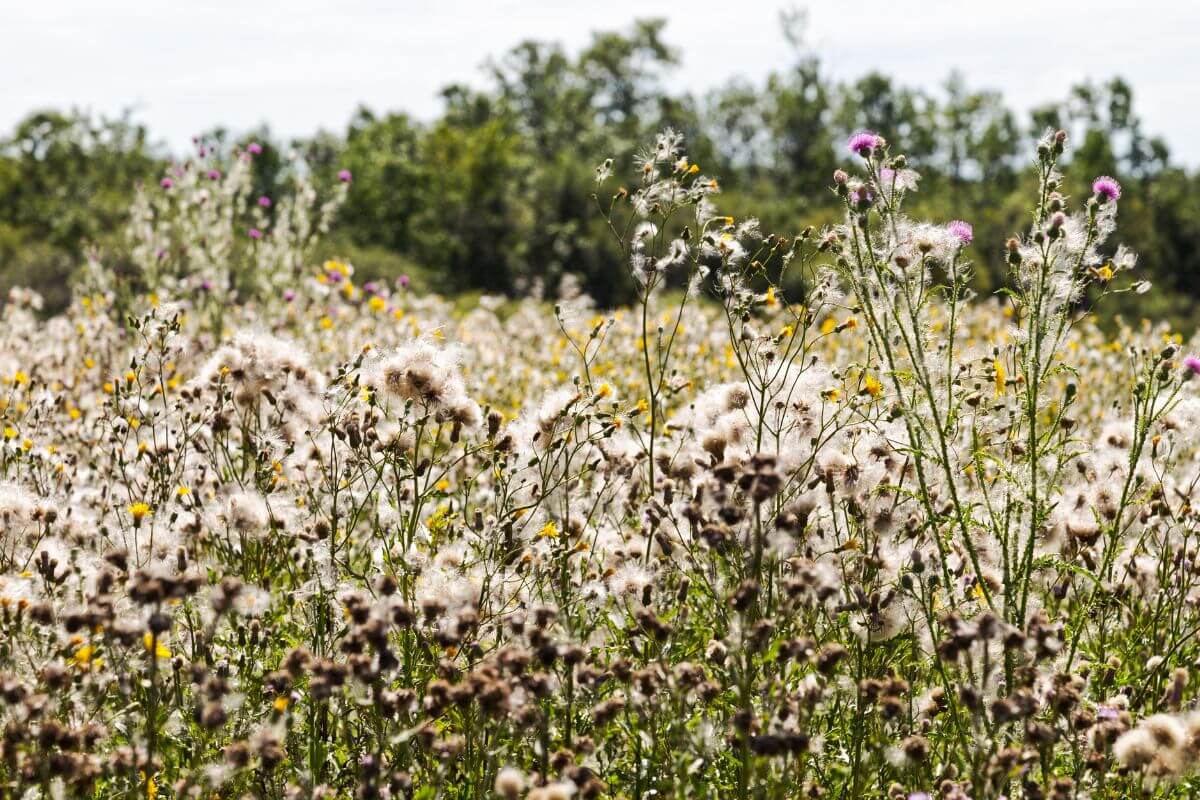
Thistles are quite common throughout the world, including Big Sky Country, though they are not to be confused with Montana’s official flower.
They are characterized by their prickly leaves and typically purple flower heads, although they can also have occasionally pink or white flowers.
Thistles can be both native and exotic to a region, and can often be identified by their female plants, which have distinctive flower heads.
Despite being considered weeds, thistles have been found to play important ecological roles in supporting diverse plant and animal communities.
Efforts to manage thistles typically involve techniques such as hand-pulling plants, preventing the dissemination of weed seeds, and utilizing an integrated weed management strategy.
In Montana, the Montana Weed Control Association and county weed districts work to maintain the health and diversity of native plant communities while controlling the spread of invasive weed species like the Canada Thistle.
- Related: Plants in Montana
Exotic vs Native Thistles: What’s the Difference?
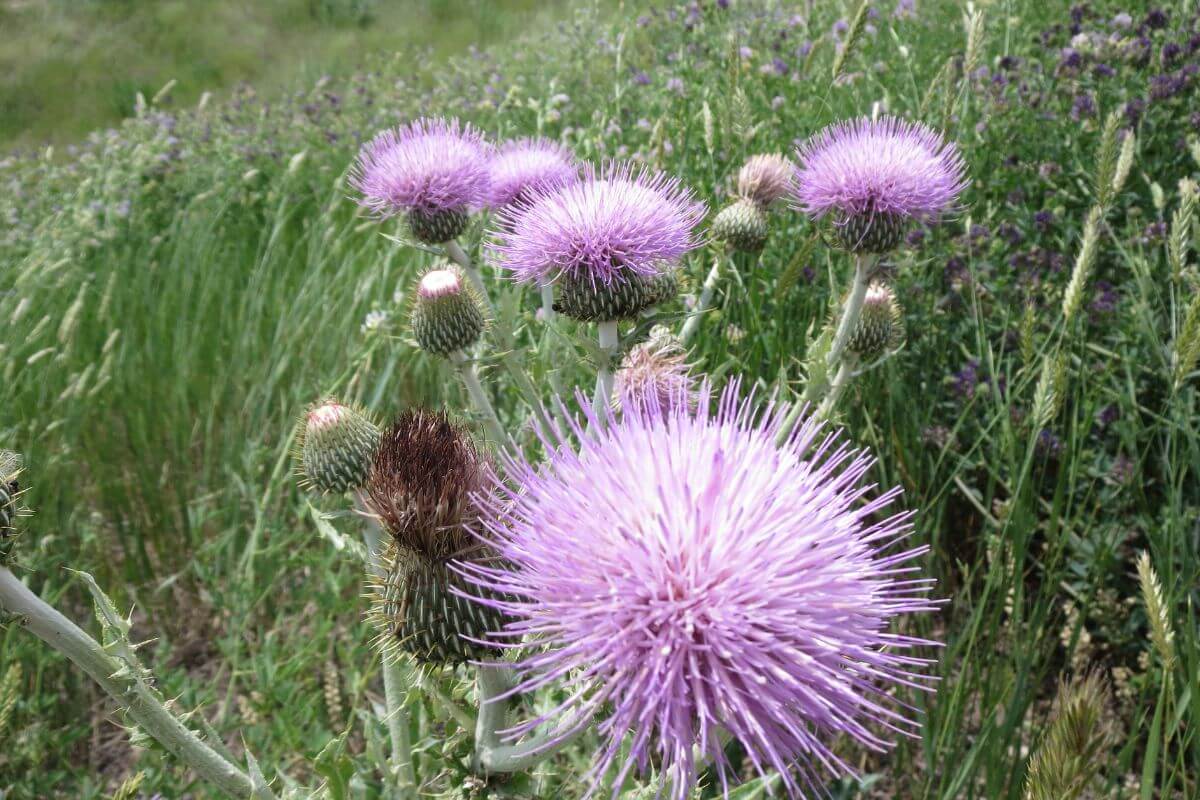
At first glance, thistles can look similar.
Exotic thistles, also known as non-native thistles, refer to thistle species that are not originally found in Montana. On the other hand, native thistles are species that have been present in Montana for thousands of years.
A significant difference between exotic and native thistles is their spreading habits.
Exotic thistles tend to be more invasive and aggressive in crowding out the surrounding native plant communities, affecting crop and forage yields.
Meanwhile, native thistles tend to coexist with other native plants, supporting diverse plant and animal communities.
It is essential to recognize the differences between exotic and native thistles to develop appropriate management strategies.
When managing exotic thistles, it is crucial to adopt strict measures such as limiting seed dissemination, preventing the growth of non-native populations, and controlling the spread at every opportunity.
Exotic Thistles in Montana

Montana’s exotic thistles pose a significant threat to the state’s native plant communities, crop and forage production, and overall ecosystem.
These invasive and aggressive plants have adapted to thrive in Montana’s climate and landscapes, making them challenging to control and eradicate. Let’s learn more about them.
1. Bull Thistle
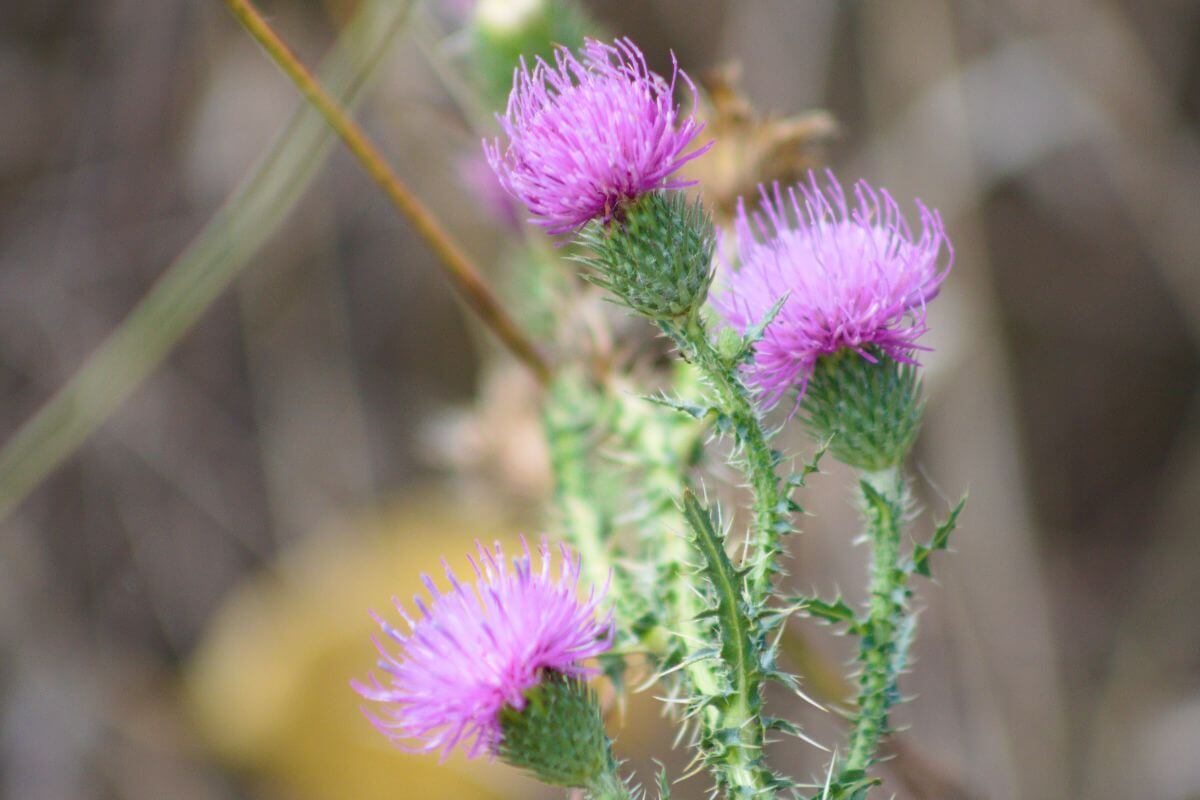
Bull thistle (Cirsium vulgare) is an invasive species of thistles in Montana that poses a serious threat to native plant communities.
This exotic plant is known for its tall stature, large purple flower heads, and sharp spines that make it difficult to handle. It can grow up to 7 feet tall.
Bull thistle is typically found in disturbed areas, such as roadsides, pastures, and fields, and can quickly spread to surrounding areas. To manage the Bull Thistle, early detection and rapid response are crucial.
By implementing proper weed management strategies, such as hand-pulling and herbicide application, the spread of bull thistle populations can be prevented.
2. Canada Thistle
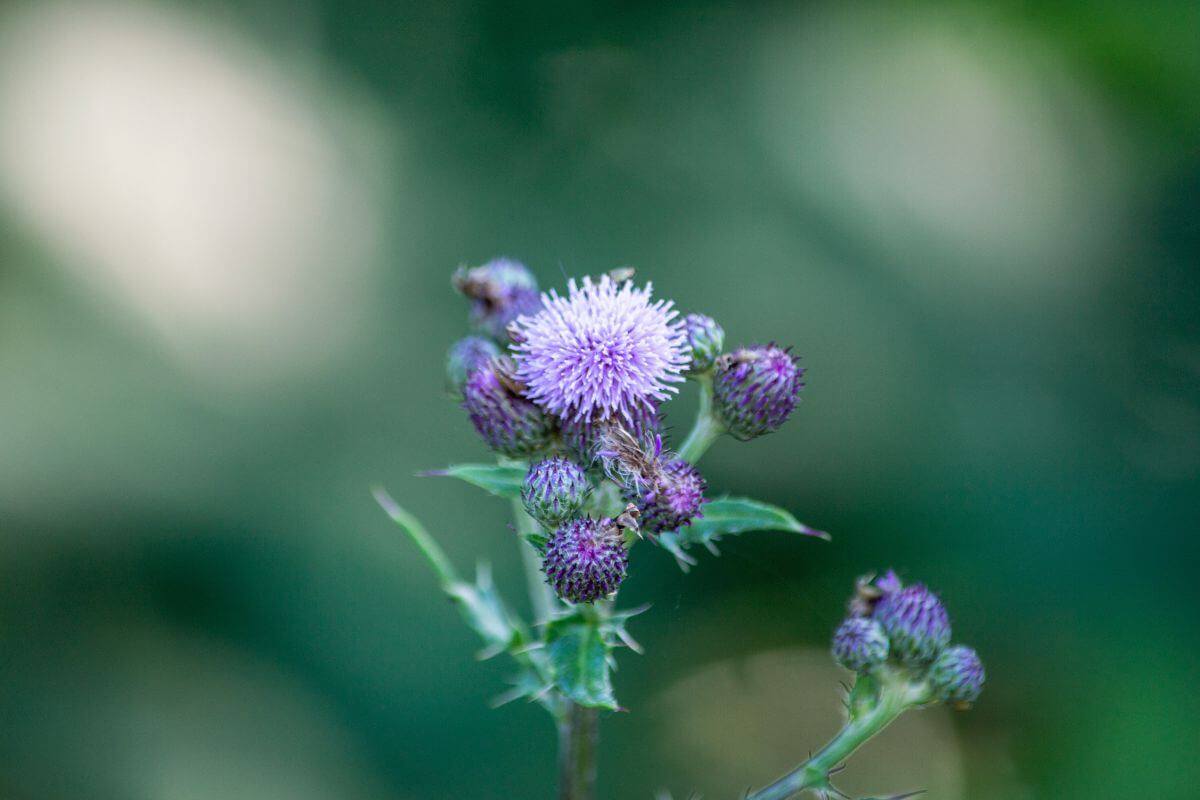
Canada Thistle (Cirsium arvense) is also known as creeping thistle, Californian thistle, corn thistle, or field thistle. This invasive species is native to Europe, Asia, and Africa.
It was introduced to North America during the 1600s and has now spread to areas such as Montana and South Dakota.
It is a dioecious plant, meaning that there are separate male and female plants. It can be found in a variety of habitats such as pastures, meadows, and roadsides.
Field Thistle is a persistent weed with a vigorous root system and the ability to quickly spread. Its aggressive nature can outcompete native plant species and reduce crop and forage yields.
The female flower head of the Canada Thistle is distinctive, with pinkish-purple flowers and a spine-tipped bract that surrounds the base.
Control of this weed can be difficult, but effective management strategies include hand-pulling plants before they flower and utilizing herbicides targeted at the entire plant, including the roots.
3. Musk Thistle

Musk thistle (Carduus nutans), also known as nodding thistle, is an invasive species with a distinctive appearance.
It features a tall stem that can reach up to 6 feet and is covered in spiny leaves and has purple or pink flowers.
This thistle can be found throughout North America, including Montana where it is considered a noxious weed. It thrives in disturbed areas such as roadsides, pastures, and rangelands.
Musk thistle can have a negative impact on both native plant communities and agricultural production as it competes with native plants for resources and can quickly establish monocultures.
This in turn reduces biodiversity and alters ecosystems. The weed is not poisonous to livestock. However, livestock does not usually graze in areas with spiny plants.
Efforts to control the spread of this invasive species in Montana have included hand-pulling and herbicide treatments.
4. Plumeless Thistle
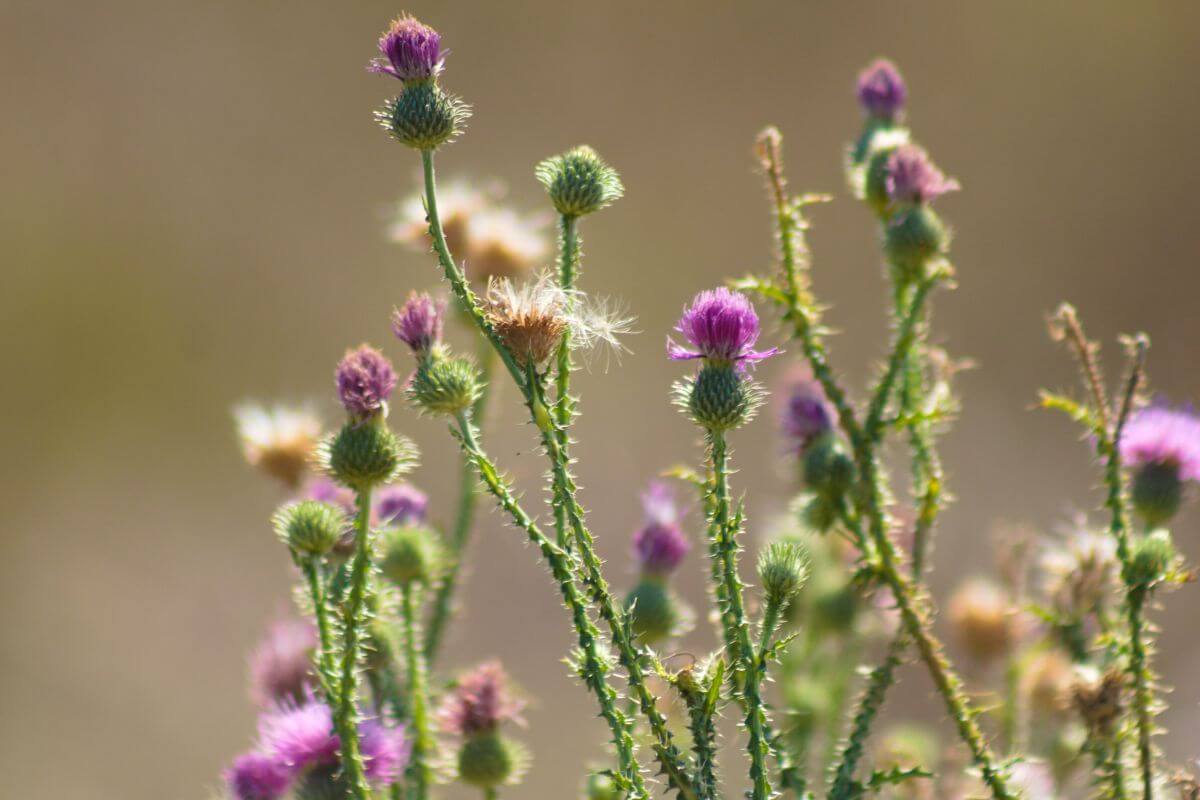
Plumeless Thistle (Carduus acanthoides) is commonly confused with Canada Thistle, but it has unique characteristics that set it apart.
Plumeless Thistle is distinguished by its lack of hair-like projections on the seed head, while Canada Thistle has feathery projections.
Despite being an invasive species, Plumeless Thistle is a valuable plant for pollinators. It produces pink to purple flowers that bloom from May to August, attracting bees, butterflies, and other pollinators.
While it has ornamental value, Plumeless Thistle can outcompete native plants, leading to a loss of biodiversity.
Montana has guidelines in place to manage Plumeless Thistle, and it is important for individuals to properly identify and report sightings to prevent this weed’s further spread.
5. Scotch Thistle
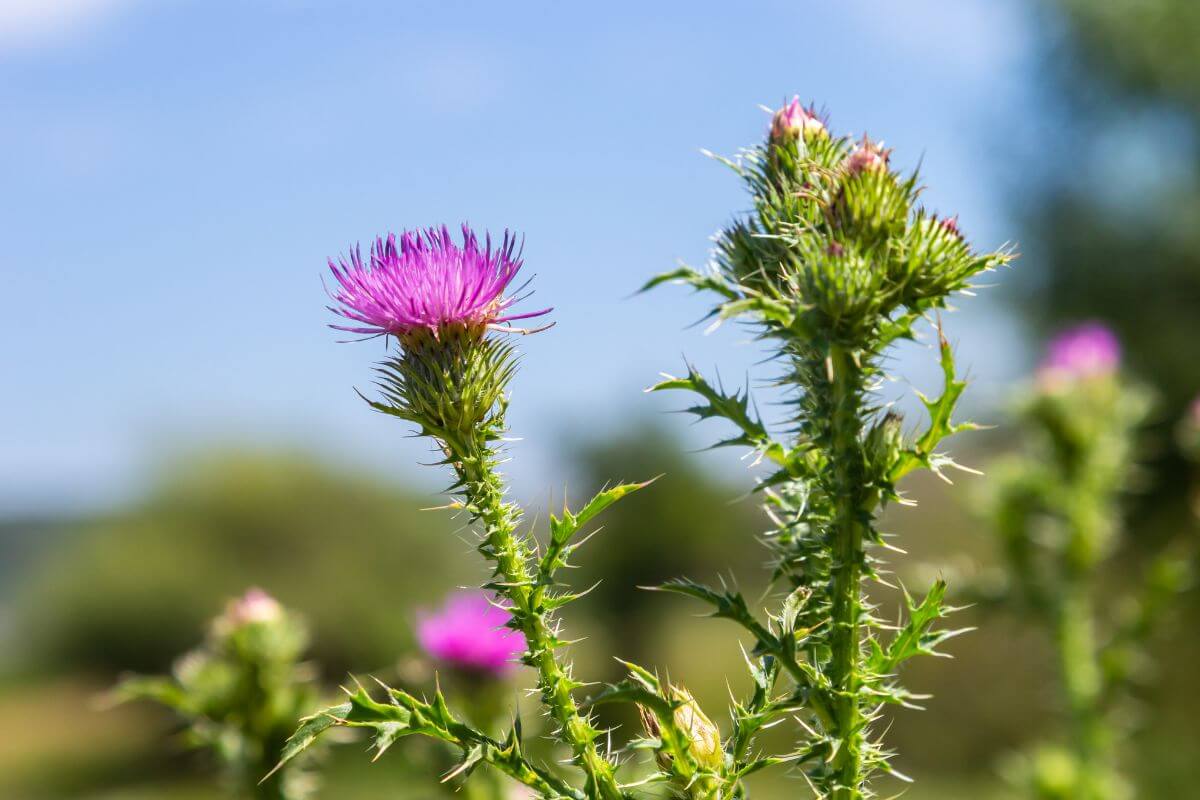
Scotch Thistle (Onopordum acanthium) is a biennial plant that can grow up to 12 feet tall. It thrives in open, sunny habitats such as pastures, roadsides, and disturbed areas in Montana.
This invasive species has a unique appearance with green, spiny leaves and showy pink-purple flowers.
Unlike the Canada Thistle, the Scotch Thistle has large, spiny floral bracts, and it has a deep and fleshy taproot making it challenging to control.
Managing the spread of Scotch Thistle is crucial due to its ability to quickly outcompete native plant species and reduce forage quality for livestock.
Physical methods such as hand-pulling and mowing can provide partial control of small infestations but often require repeated treatments.
Chemical options, including herbicides, can be effective for large infestations but should be used with caution to avoid damage to non-target plants and wildlife.
Native Thistles in Montana
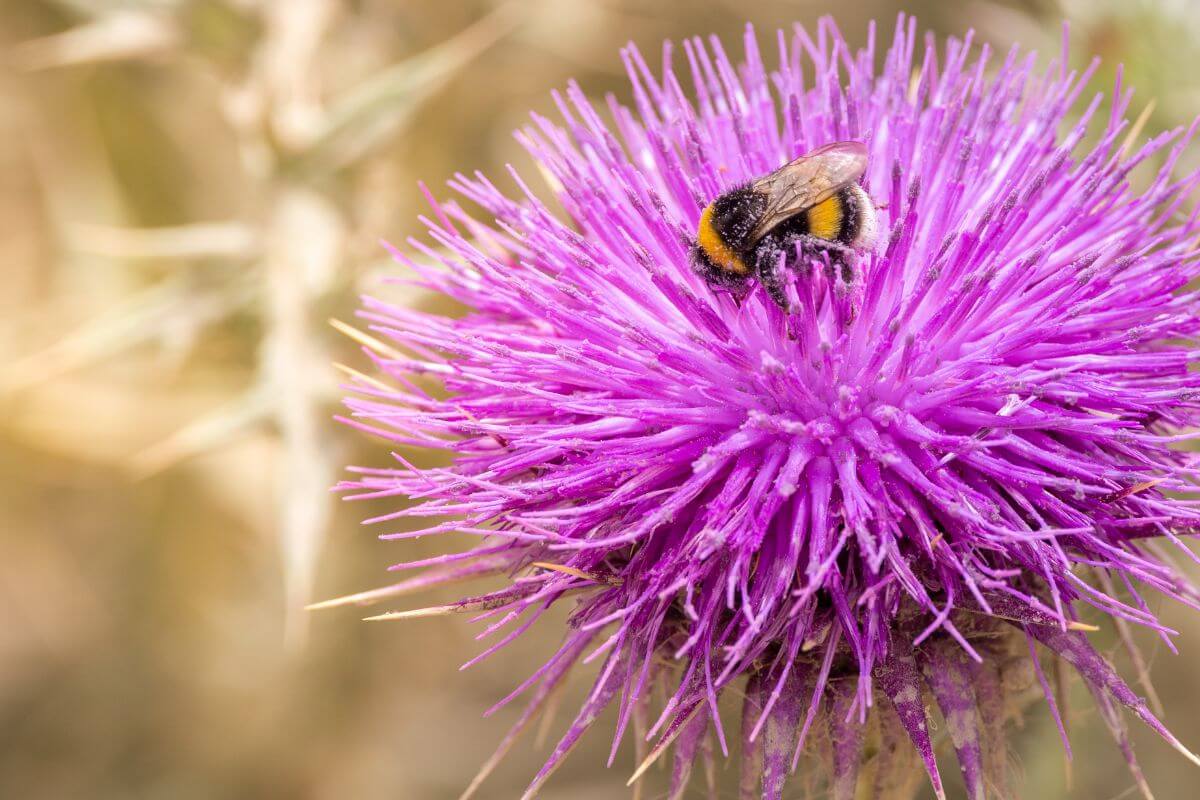
Montana is also home to a variety of beautiful and unique native thistles that play an important role in the state’s ecosystem.
Despite their beauty and ecological contributions, thistles are often seen as weeds and are subject to control measures. Let’s learn more about them.
1. Clustered Thistle
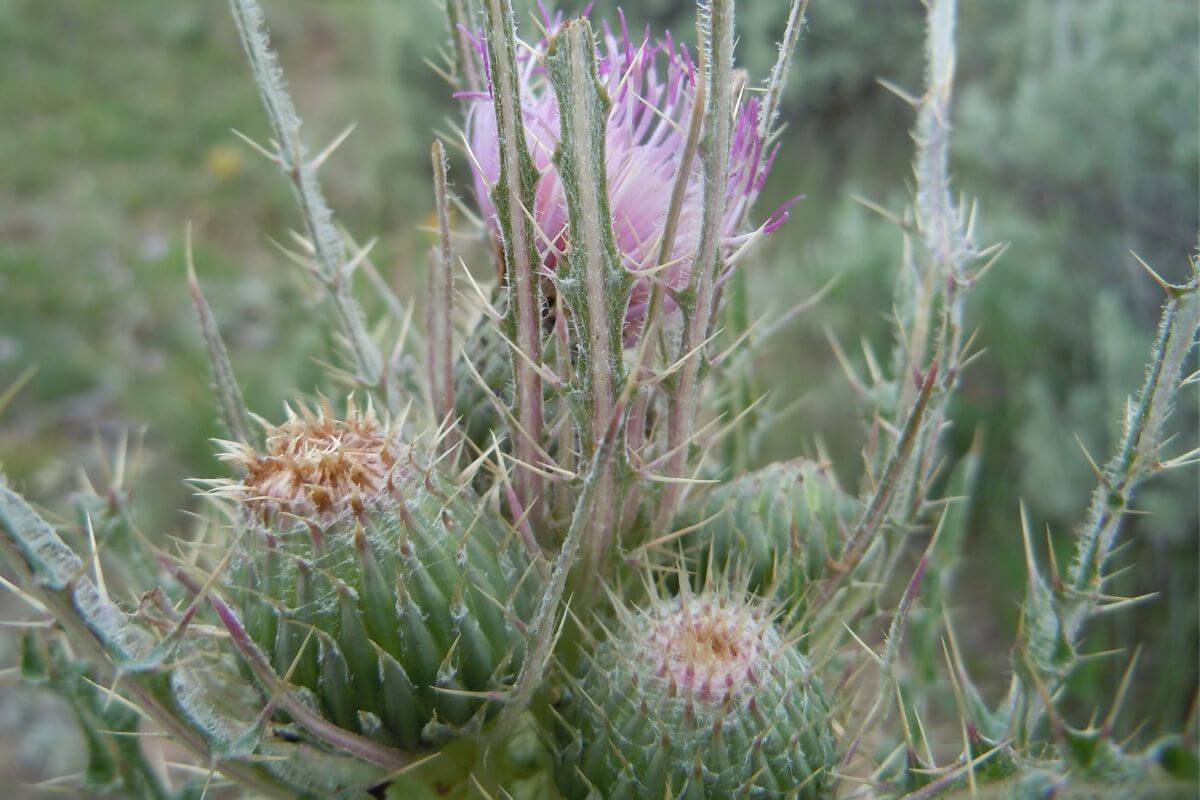
Clustered Thistle (Cirsium brevistylum) or Indian Thistle is a native Montana perennial herb that is easily recognizable by its large, pink or purple flower heads, which are surrounded by bracts with long tapering
tips and cobwebby hairs.
Clustered Thistle prefers to grow in well-drained soil and is often found in meadows and sagebrush steppe with high native plant cover and adjacent to seldomly used roads.
It blooms in the summer months, attracting a variety of pollinators such as bees, butterflies, and hummingbirds.
This native thistle plays a crucial role in the ecosystem by providing important habitat and food sources. Therefore, it is essential to protect and conserve this species in Montana.
2. Flodman’s Thistle
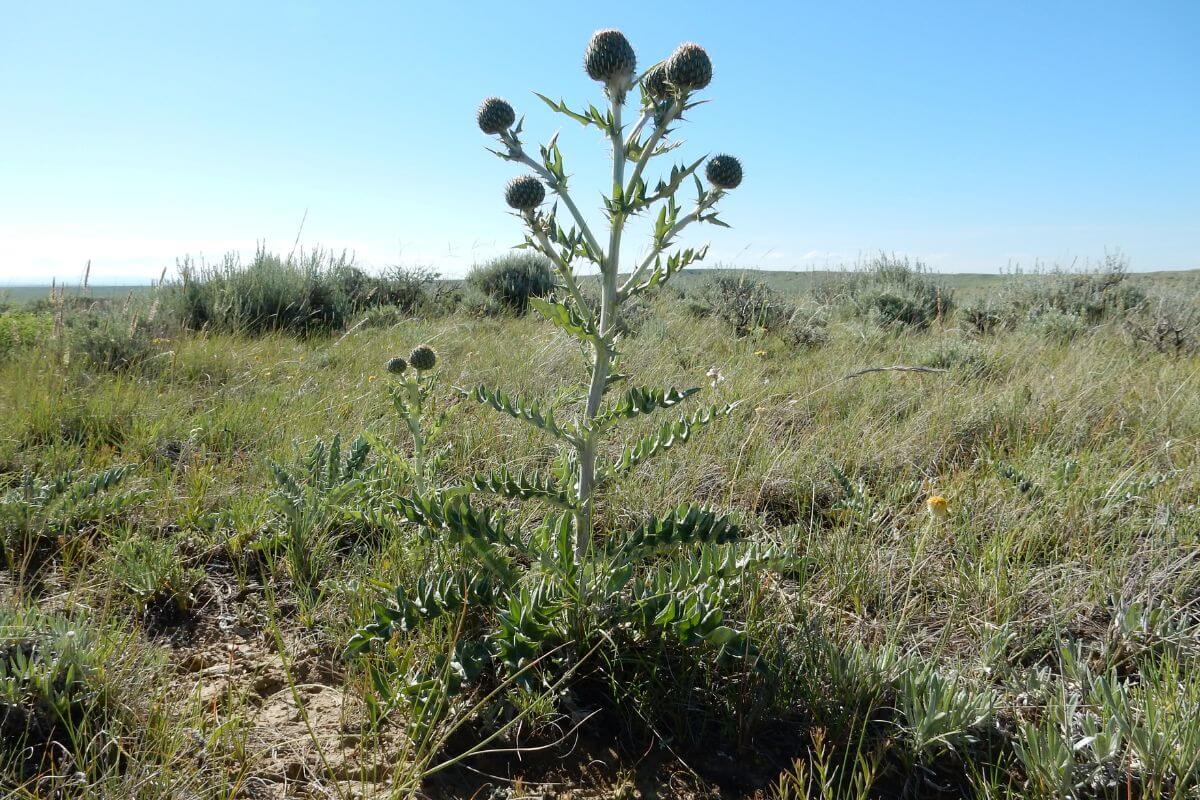
Flodman’s Thistle (Cirsium flodmanii) is a native Montana plant that belongs to the Asteraceae family. It is a perennial plant that commonly grows from 1-4 feet tall.
Its physical appearance includes narrow leaves with spiny edges and silvery gray undersides. It produces clustered lavender flowers that bloom between July to September.
Its weed-like structure usually inhabits grasslands and meadows often along streams and wetlands.
Flodman’s Thistle holds an ecological significance regarding pollination and herbivory. The plant attracts several pollinators, including bees, wasps, and butterflies with its beautiful flowers and nectar.
Additionally, the thorny structure of the plant protects it from being eaten by herbivores like deer and elk.
3. Eaton’s Thistle
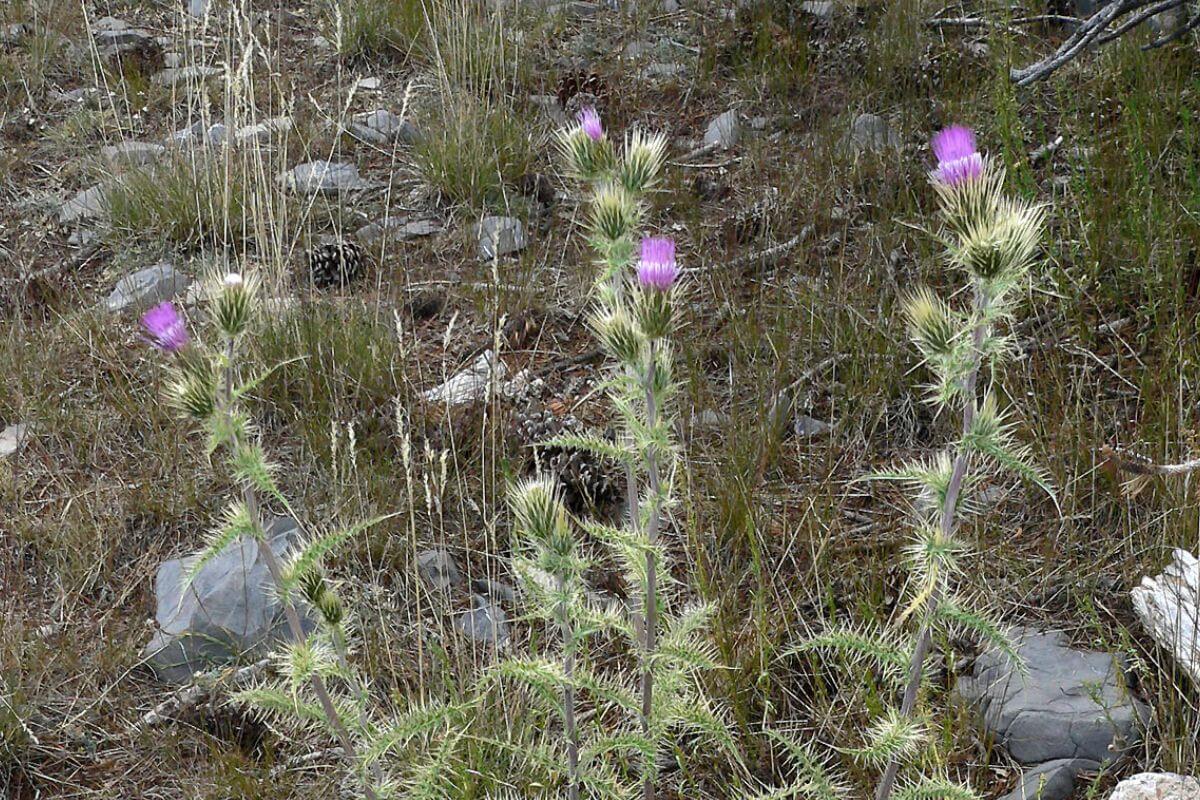
Eaton’s Thistle (Cirsium eatonii) is also known as the mountaintop thistle.
It can grow up to 5 feet tall and has a striking appearance with its vibrant pink, purple, or yellow flowers and unique leaf shape.
Eaton’s Thistle prefers to grow in dry or moist soils and can usually be found in meadows, talus, or mountain slopes at high elevations (subalpine to alpine).
While Eaton’s Thistle is considered to be beneficial to its natural ecosystem by providing food and habitat for wildlife, its rapid growth habits can also pose a threat to agriculture and range management practices.
Effective management strategies have been implemented to prevent the spread of this thistle, including herbicide applications and mechanical removal methods.
4. Gray Green Thistle
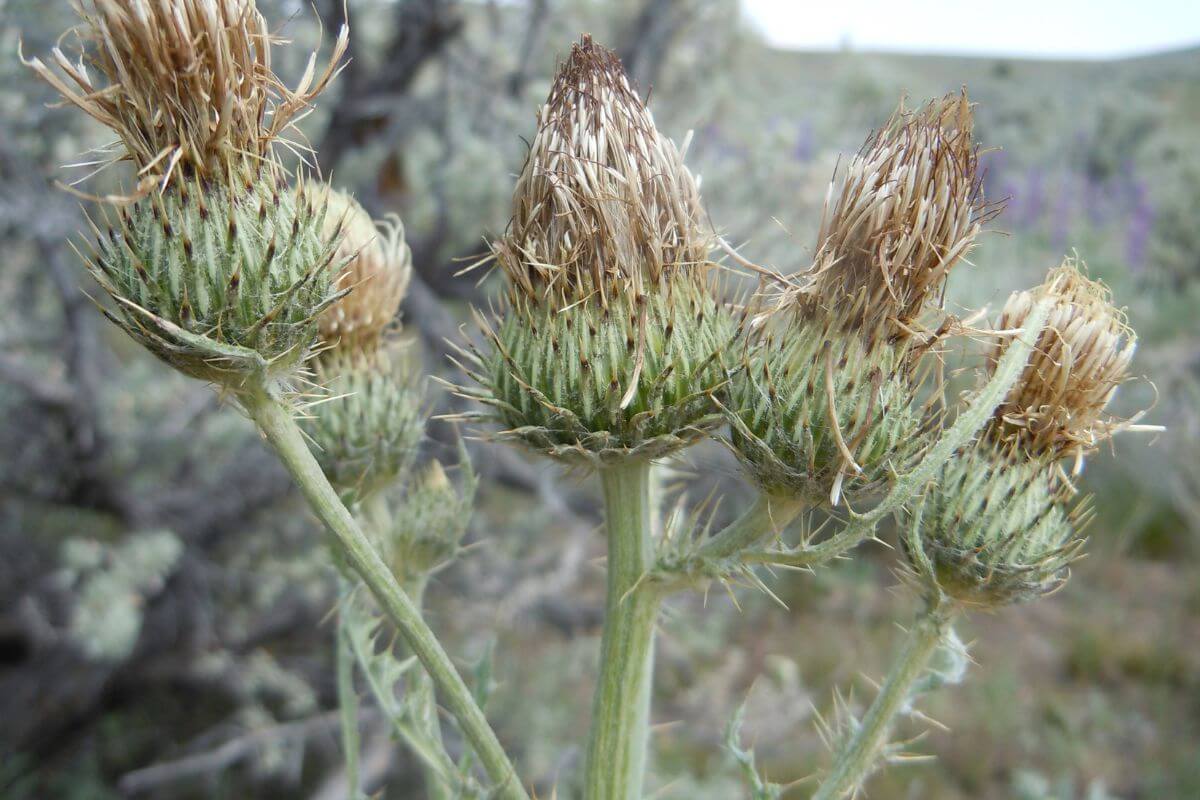
Gray Green Thistle (Cirsium canovirens) is a native Montana species that belongs to the Asteraceae family.
This perennial herb has a grayish-green color with flowers that range from white to purple. Its leaves are decurrent on the stem with the upper and lower leaves covered in sparse, wooly hairs.
The gray green thistle usually inhabits sagebrush steppes, grasslands, and open forests and is found
in higher elevations (montane to subalpine).
Although gray green thistle is a native species and has some benefits, such as providing food and habitat for pollinators, it also has drawbacks.
It can be invasive in non-native habitats and can quickly spread, reducing diversity and disrupting the natural ecosystem.
To control the spread of gray green thistle, management methods such as hand-pulling, prescribed burning, and herbicide treatment can be employed.
5. Longstyle Thistle
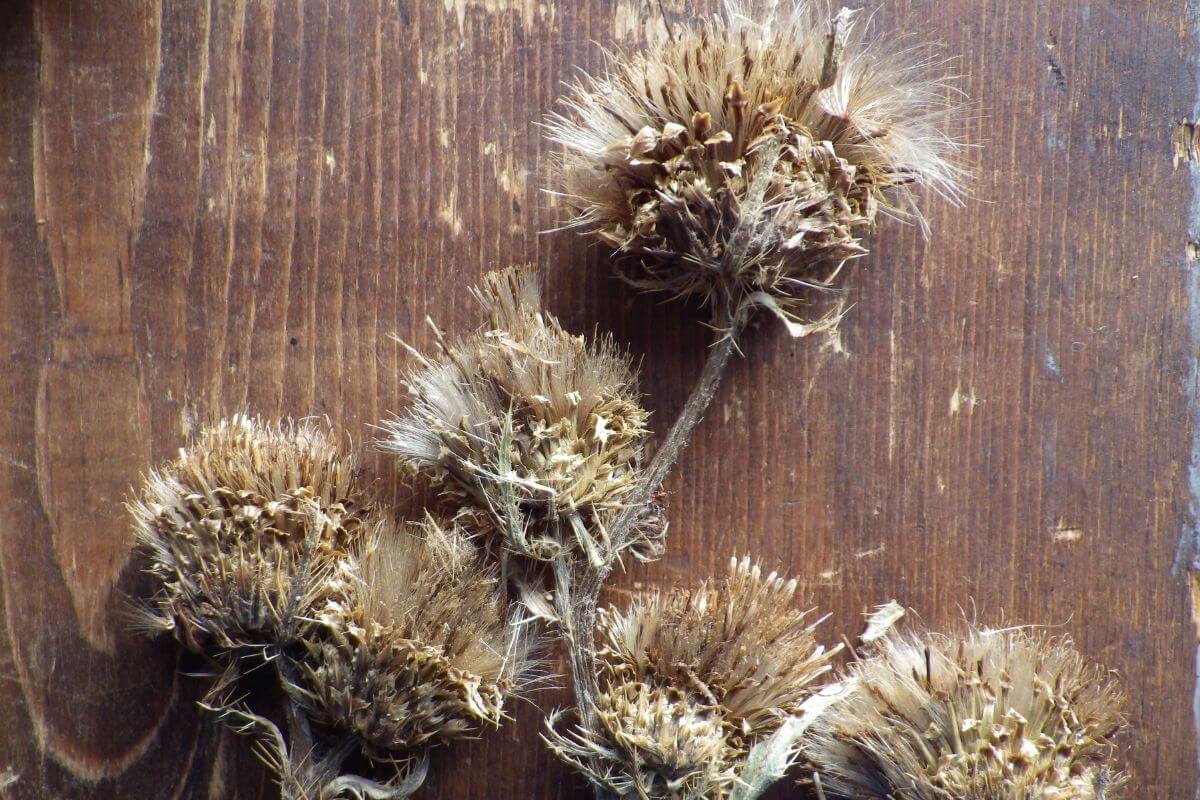
Longstyle Thistle (Cirsium longistylum) is a native species found in meadows, moist forest openings, and roadsides at high elevations (upper montane, lower subalpine) in Montana. It can grow up to 5 feet tall.
This plant is endemic to west-central Montana and is tagged as a species of concern.
Known for its long stigmas, longstyle thistles have become a significant component of native plant communities in the area.
Correct plant identification of this thistle species is necessary to avoid confusion with other invasive thistle species, such as the Canada Thistle.
6. Prairie Thistle
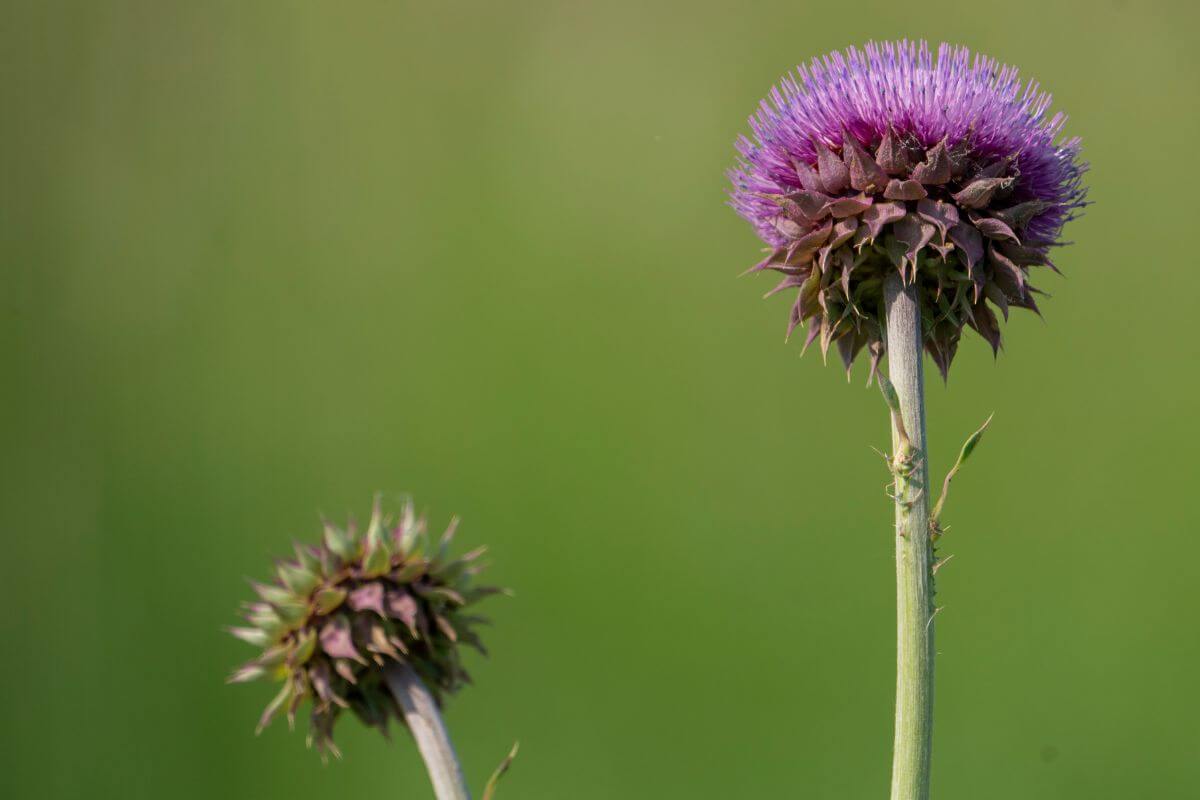
Prairie Thistle (Cirsium canescens) is a common plant species found in Montana. it belongs to the Cirsium genus and the Asteraceae family.
This beautiful thistle can grow up to 4 feet tall and has white or purple flowers that bloom from May to August. It can be found throughout Montana, thriving in grasslands and woodlands at lower elevations.
Proper management practices can help control this plant’s growth while still preserving its ecological importance in Montana’s diverse ecosystems.
7. Meadow Thistle
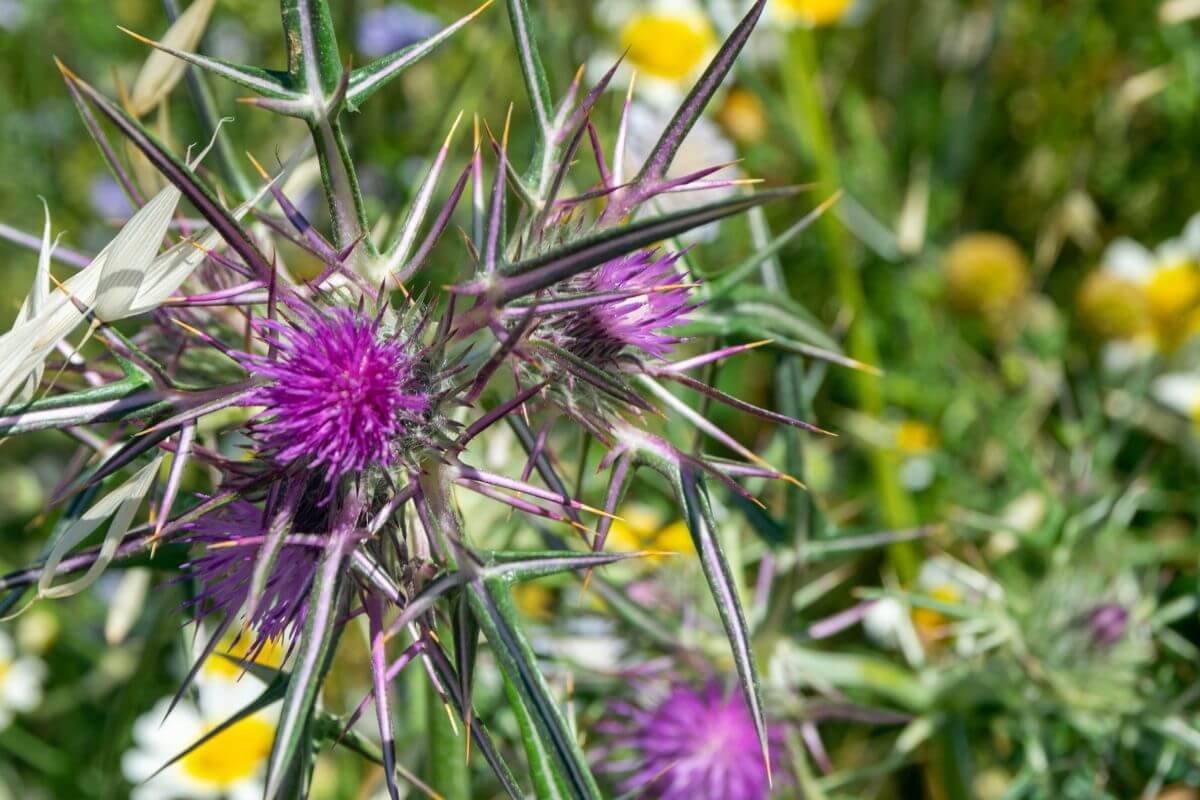
Meadow Thistle (Cirsium scariosum), also known as elk thistle or dwarf thistle, is a native plant found in Montana that can grow up to 6 feet tall.
It features showy white to purple flowers that bloom from June to August, making it an attractive choice for gardeners and pollinators.
Meadow or Elk thistle is typically found in moist to wet grasslands (sometimes calcareous) and
mountain meadows from low to high elevations in Montana.
It is an important component of the state’s native plant communities.
8. Wavy Leaf Thistle
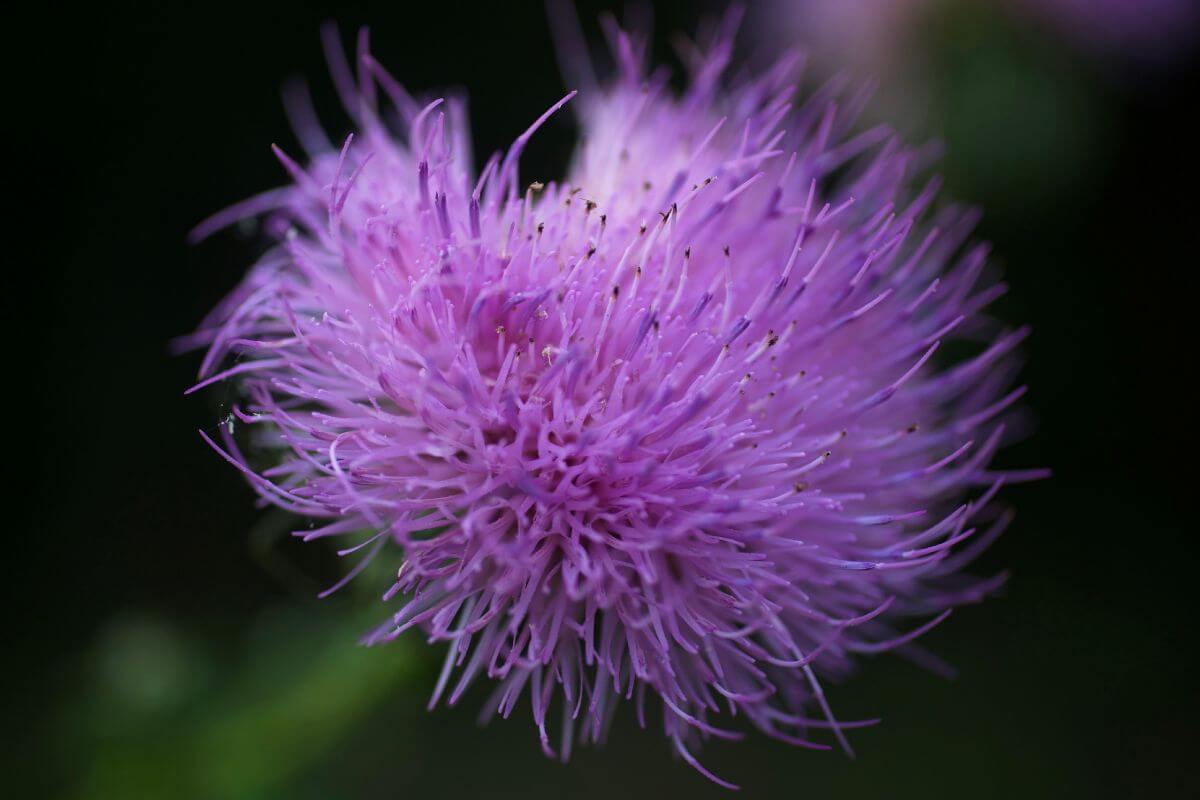
Wavy Leaf Thistle (Cirsium undulatum) is a noxious weed found in Montana and other parts of North America. It is commonly confused with Flodman’s Thistle due to its appearance.
To compare, a wavy leaf thistle is larger than a flodman’s thistle and prefers much drier conditions than the latter. They inhabit grasslands, sagebrush steppe, and roadsides.
The plant’s physical appearance includes wavy, spiny leaves, and a flower head that is pink or lavender and occasionally white in color. It blooms during the months of July to September.
It is a perennial plant and can grow up to 4 feet in height.
Native American tribes are said to have used wavyleaf thistle to treat gonorrhea and syphilis. While others have reported that tea or soup from its roots can be made to treat diabetes and stomachache.
Regardless of its uses, however, the wavy leaf thistle still competes with native plants and impacts local ecosystems, making it important to manage it to mitigate impacts.
Management techniques include pulling it by hand, cutting the plant before seed production, and using herbicides in areas where the plant is widespread.
Proper disposal methods include either burning the plant or sending it to the landfill.
9. White Thistle
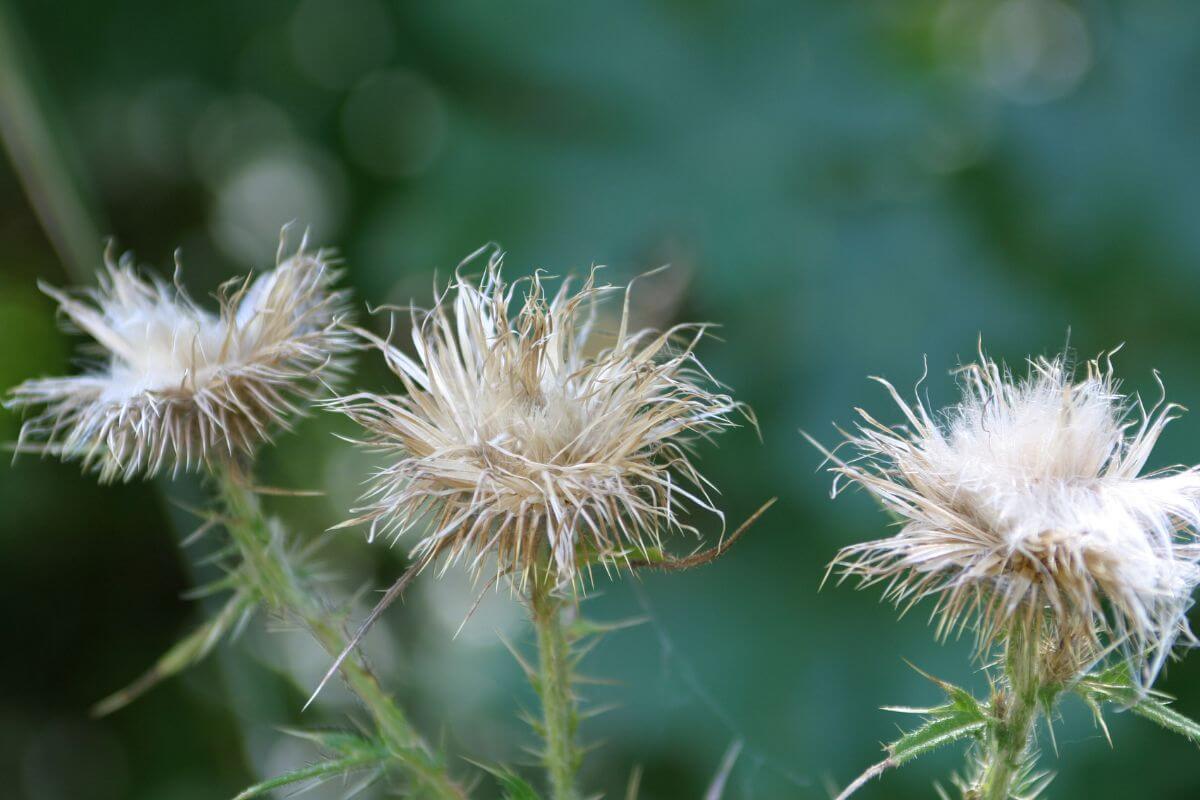
White Thistle (Cirsium hookerianum), also known as Hooker’s Thistle, is a stunningly beautiful but difficult-to-identify native thistle species in Montana.
This short-lived perennial plant thrives in moist lowlands, open slopes, and fields and produces creamy-white flowers during the months of July and August.
It has leaves that have loose, soft hairs above, are toothed, and moderately spiny. Due to its limited distribution, little is known about its population trends and current status.
As such, conservation efforts for the white thistle are urgently needed to protect this special Montana species from further decline.
10. Wyoming Thistle

Wyoming Thistle (Cirsium pulcherrimum) is a plant that can grow up to 3 feet tall and produces pink to purple flower heads that bloom from June to July.
It has short bracts like the Canada thistle. While its stems and leaf undersides are white due to dense hairs, its upper leaf surface is dark green in color and almost hairless.
The Wyoming Thistle may look like a beautiful addition to any garden or landscape, but it can actually have negative impacts on the local environment. So it’s important to control its growth and spread.
Montana Thistles Final Thoughts
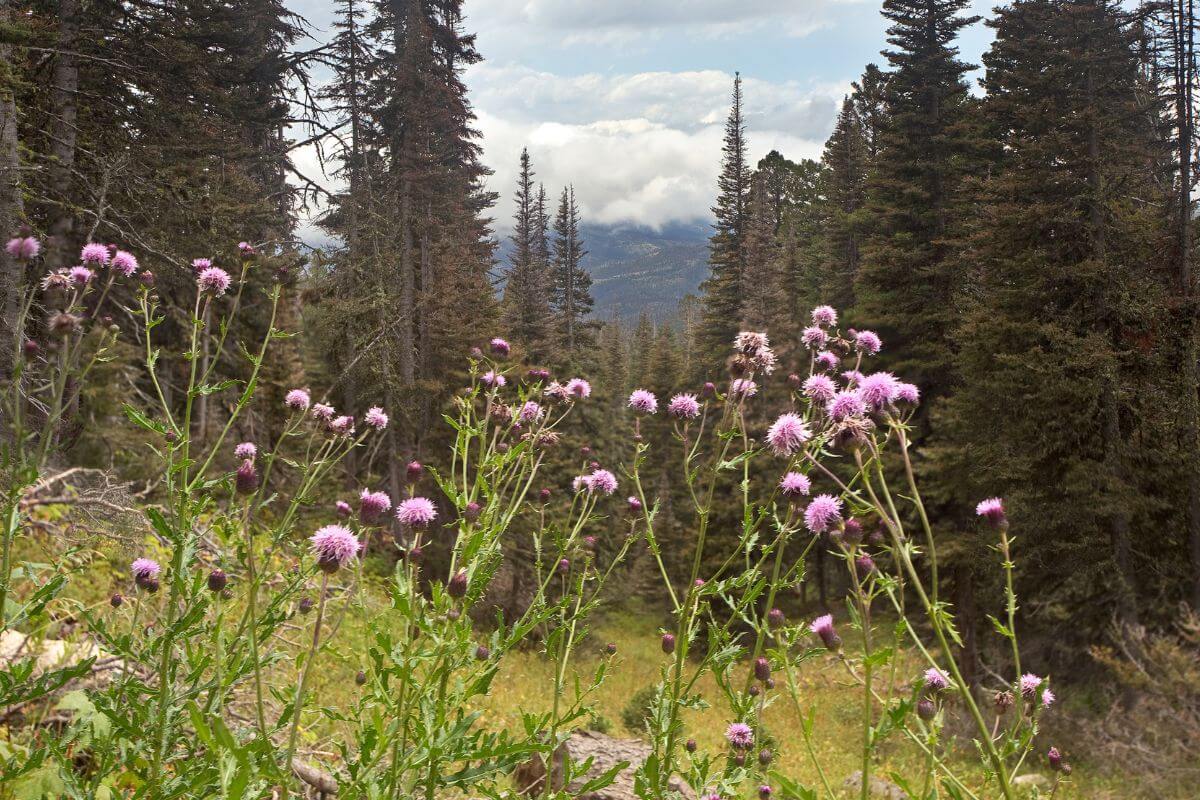
Montana has 5 exotic thistles and 10 native thistles in total. And while some may be used for medicinal purposes and as a source of food and shelter, their disadvantages far outweigh their benefits to the community.
Most thistles compete with and displace native plants, leading to reduced biodiversity and ecological imbalances. In addition, it poses problems for agriculture.
Effective management techniques for Montana thistles include hand-pulling, mowing, and the use of herbicides.
Proper disposal of any removed plants is important as well to effectively prevent the spread of their seeds.
You can either do a controlled burn on the area of infestation or cut the thistles, wrap it properly, and send it to a landfill. Do not compost or mix it with yard waste.
The Montana Weed Control Association and Noxious Weed Legislation provide resources and guidelines for the proper management of Montana thistle.
It is crucial to distinguish thistles from native plants to avoid inadvertently targeting the wrong plants in management efforts.
Montana Thistles FAQs
If you’re dealing with thistles, you may have many questions about how to control or handle them effectively. We’ll answer some of the frequently asked questions about them in the following sections.
1. Are Thistles Invasive in Montana?
Exotic thistles such as the Bull Thistle, Canada Thistle, Musk Thistle, Plumeless Thistle, and Scotch Thistle are the most invasive in Montana.
They can be detrimental to crop and forage production. Noxious weed legislation is in place to control its spread.
2. What Is the Best Treatment for Thistles?
Thistles can be difficult to control, but there are several treatment options available to prevent it from spreading and hurting anybody. Here are some:
- Physical control – mowing or cutting off the tops of plants or using a weed-eater
- Hand-pulling plants – effective for smaller infestations
- Chemical control – using herbicides
- Cultural control – promoting healthy plant growth and reducing disturbance
- Biological control – introducing natural predators or competitors to the thistle population
The best treatment option depends on the specific situation and type of thistle present.
3. How Do You Eat Thistle?
Edible thistle plants can be harvested and eaten when they are young and tender just before they flower.
Thistle leaves can be prepared in a variety of ways, including being sautéed, roasted, or added to soups and salads. Some thistles that can be eaten are Canada, bull, and plumeless thistles.
4. Is the Thistle Plant Good for Anything?
The thistle plant has potential uses and benefits such as being a source of food, particularly the artichoke variety, and traditional medicines.
Native American tribes used thistles for medicinal purposes such as relieving stomach aches. Despite its reputation as a weed, the thistle plant has significant value and uses.
5. What Part of the Thistle Can You Eat?
Thistle plants have both edible leaves and roots. The leaves can be eaten raw or cooked and have a slightly bitter taste. To prepare the leaves, remove the spines and soak them in cold water for about an hour before cooking.
The roots can also be eaten and are best when boiled or roasted for a tender texture and sweet, nutty flavor.
If you want to gain further insights about Montana, check out these other articles:
- https://extension.umn.edu/identify-invasive-species/bull-thistle
- https://kingcounty.gov/services/environment/animals-and-plants/noxious-weeds/weed-identification/bull-thistle.aspx
- https://www.nwcb.wa.gov/images/weeds/Bull-Thistle-factsheet_King.pdf
- https://www.montana.edu/extension/invasiveplants/documents/publications/extension_publications/Guide%20to%20thistles_EB0221.pdf
- https://extension.sdstate.edu/dense-seeding-can-reduce-canada-thistle-planted-grasslands
- https://www.nwcb.wa.gov/images/weeds/Canada-thistle_Franklin.pdf
- https://weedscience.ca.uky.edu/content/musk-thistle
- http://www.library.nd.gov/statedocs/agdept/scotchthistle20070905.pdf
- https://www.ag.ndsu.edu/publications/crops/the-thistles-of-north-dakota/w1120.pdf
- https://fieldguide.mt.gov/speciesDetail.aspx?elcode=PDAST2E0H0
- https://fieldguide.mt.gov/speciesDetail.aspx?elcode=PDAST2E0G0
- https://www.fs.usda.gov/wildflowers/plant-of-the-week/cirsium_undulatum.shtml
- https://fieldguide.mt.gov/speciesDetail.aspx?elcode=PDAST2E2D0
- https://commons.wikimedia.org/wiki/File:Cirsium_brevistylum
- https://commons.wikimedia.org/wiki/File:Cirsium_flodmanii
- https://commons.wikimedia.org/wiki/File:Cirsium_eatonii
- https://commons.wikimedia.org/wiki/File:Cirsium_canovirens_(C.subniveum)
- https://commons.wikimedia.org/wiki/File:Cirsium_longistylum

